
When contacting us by e-mail, correspondents are asked to include their name and full postal address and, when providing information, to quote exact book and magazine sources. The word ‘chess’ needs to appear in the subject-line or in the message itself.
| First column | << previous | Archives [19] | next >> | Current column |
‘Friendly warning: Read this only when someone is in the house with you.’
Those alluring words by Ellery Queen appeared on page 464 of his anthology 101 Years’ Entertainment The Great Detective Stories 1841-1941 (New York, 1941) by way of introduction to Lord Dunsany’s macabre short story ‘The Two Bottles of Relish’. Chess is mentioned when the narrator, a relish salesman named Smithers, refers to a conversation with the detective, Linley:
‘And so one day I said to Linley, “I wonder with all that knack you have for seeing through a chess problem, and thinking of one thing and another, that you don’t have a go at that Otherthorpe [murder] mystery. It’s a problem as much as chess”, I said.
“There’s not the mystery in ten murders that there is in one game of chess”, he answered.’
The idea is reiterated when Smithers again tries to persuade Linley to investigate the murder:
‘Well, the fact was Linley didn’t take much interest in it at first, but I was so absolutely sure that he could do it that I kept him to the idea. “You can do chess problems”, I said.
“That’s ten times harder”, he said, sticking to his point.
“Then why don’t you do this?”, I said.
“Then go and take a look at the board for me”, said Linley.’
For a general introduction to Lord Dunsany, a useful book, which includes references to chess and his meeting with Capablanca, is Mark Amory’s 1972 biography:

Avital Pilpel (Haifa, Israel) writes:
‘Moshe Czerniak was a strong player also known for his sense of humor and love of the game. Here are some items from the biography of him by Yochanan Afek and Horacio Volman, Ad Ha’ragli Ha’acharon (Fighting to the Last Pawn), which was published in Israel in 2000.
Page 33 has an excerpt from page 59 of Czerniak’s Toldot Ha’shachmat Mi’reshito ve’ad Yameynu (The History of Chess from its Beginnings to the Present), published in Tel Aviv, 1963:
“In the [1939] Olympiad I had the opportunity to play against Capablanca in two games. In the first the champion had an extra pawn, but a slight inaccuracy was enough for him to miss the win. The draw which resulted greatly annoyed him: ‘I can see the headlines: “Capablanca’s getting old”’, he told me. In the second game he showed that this was not the case; his combination stunned me, as if I had been hit over the head.”
Moshe Czerniak and José Raúl Capablanca, Buenos Aires, 1939
Page 41 provides an extract from Czerniak’s Israel Be’olympiadot Ha’Schachmat (Israel in the Chess Olympiads), published in Tel Aviv in 1979:
“My game with the Norwegian Rojahn in the 1939 Olympiad received opposite comments from two world champions. While Alekhine followed it closely (and even published it with his notes), Capablanca dismissed it with a barb: ‘They call this chess, too?’”
Page 83, from page 94 of Czerniak’s above-mentioned history of chess:
“In the Moscow Olympiad of 1956 I lost my game against Szabó. I missed a chance to win, and obviously was not in a great mood. Szabó started explaining that even if I had not missed the crucial combination he would still have had a chance to draw. A young Russian Jew stopped next to our analysis board and said politely but with complete assurance, ‘you wouldn’t have had a chance to draw in that case’, and instantly started to show us the variations which could have occurred, at lightning speed. His analysis was brilliant and convincing. This was how I met Mikhail Tal.”
Page 123 relates Czerniak’s comment after losing a game in his last tournament (in 1984, when he was aged 74), to the 11-year-old Yinon Boim:
“I was the one who played like a child.”’
The 1910 Lasker v Schlechter controversy (was it a world championship match and, if so, did Schlechter have to win by two points to gain the title?) has been referred to, inconclusively, in several C.N. items. Now Richard Forster (Winterthur, Switzerland) submits the following report by Walter Preiswerk (who was then in Leipzig) in the Basler Nachrichten of 20 February 1910, i.e. ten days after the Lasker v Schlechter match ended (+1 –1 =8):
‘... Man nahm nun allgemein an, die letzte Partie werde mit remis enden, und Schlechter werde sich dadurch den Sieg sichern. Aber merkwürdigerweise gewann Lasker und machte so den Wettkampf unentschieden. Es ist wirklich seltsam, dass Schlechter, der von 9 Partien keine verlor, nun gerade in der letzten unterlag, und die Annahme, dieser Ausgang sei beabsichtigt gewesen, liegt nahe. Ein knapper Sieg Schlechters hätte diesem nämlich keineswegs die Weltmeisterschaft eingebracht, sondern einen ernsten Revanchekampf zu Folge gehabt, der ohne Rücksicht auf seine Finanzierung hätte ausgetragen werden müssen. Dies mag beiden Meistern, die ja auch ausgezeichnete Geschäftsleute sind, nicht gepasst haben. - Das Resultat des Matchs ist übrigens die konsequente Folge seiner Bedingungen, und man könnte ihm den Wahlspruch geben: “Tu mir nichts, ich tu dir auch nichts!”’
It is difficult to know quite what to make of this commentary. Below, in any case, is our English translation:
‘It was generally assumed that the last game would end in a draw and that Schlechter would thereby ensure victory for himself. Curiously enough, however, Lasker won, which meant that the match ended indecisively. It is very strange that Schlechter, who lost none of the first nine games, succumbed in the final one, and the assumption suggests itself that this outcome was intentional. A narrow victory by Schlechter would by no means have given him the world championship but, instead, it would have brought him a serious return match to be carried out irrespective of its financing. This may not have suited the two masters, who, after all, are also excellent businessmen. The result of the match is, incidentally, the logical consequence of its conditions, and it could be accorded the motto, “Do not kill me, and I shall not kill you”.’
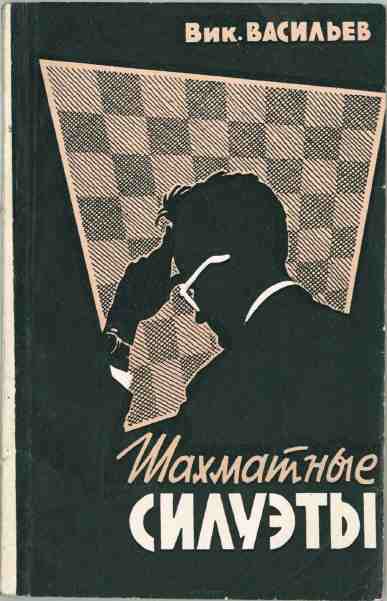
Calle Erlandsson (Lund, Sweden) draws attention to the front cover of V.L. Vasiliev’s book Shakhmatnye Siluety (Moscow, 1961). Although it features the silhouette of a chessplayer, the six masters accorded a chapter each (Petrosian, Korchnoi, Simagin, Smyslov, Tal and Ragozin) are illustrated by caricatures, not silhouettes.
The picture below was reproduced in C.N. 2740, from the Dizionario Enciclopedico degli Scacchi by A. Chicco and G. Porreca (Milan, 1971):
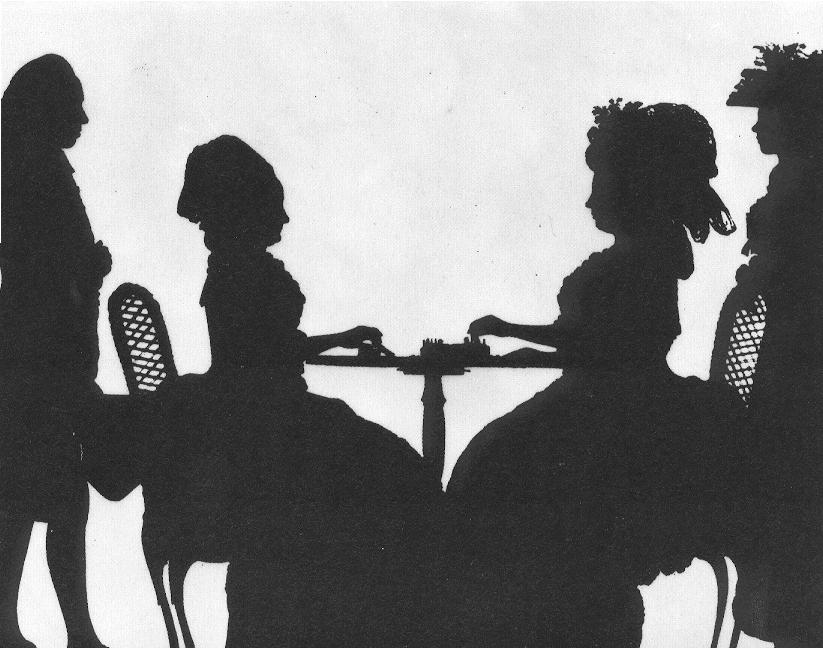
‘Una silhouette rappresentante Giocatrici di scacchi, di ignoto, del XVIII secolo’
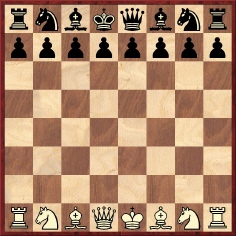
White to play and mate in four.
This position, given in C.N. 4141, is illegal/impossible, and the board therefore needs to be turned 180 degrees, after which the key move for White is 1 Nc6 (or 1 Nd7).
As a curiosity we add that when Lord Dunsany’s famous short story ‘The Three Sailors’ Gambit’ was published in his 1916 volume The Last Book of Wonder, it was entitled (in the heading, although not in the table of contents) ‘The Three Sailors’ Gamble’:
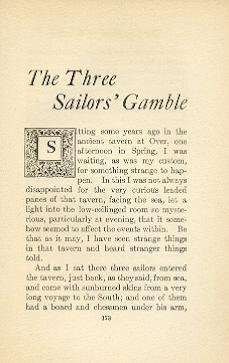
To the small number of volumes on Tartakower mentioned in C.N.s 3900 and 3904 Yakov Zusmanovich (Pleasanton, CA, USA) adds:
‘There was a 32-page Czech booklet “Remízové” vĕžovky S.G. Tartakowera by Josef Hladík (Brno, 1995). It contains 60 rook endings by Tartakower played between 1907 and 1951.’
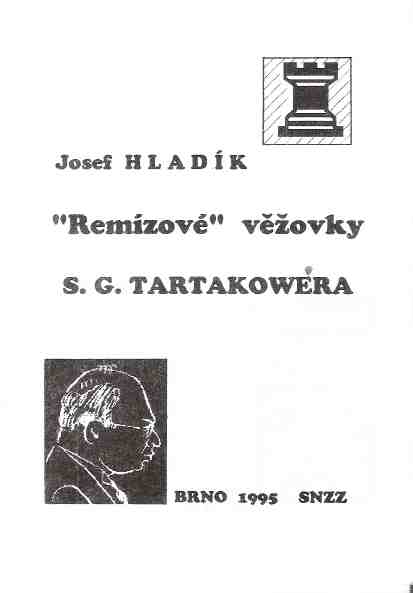
Frank Mayer (Barcelona) asks for information about the final resting-places of the three Soviet world champions Botvinnik, Tal and Petrosian.
Avital Pilpel (Haifa, Israel) submits two photographs from Shaul Hon’s book Ptichot be’Shachmat (‘Chess Openings’), i.e. the third edition published in Tel Aviv in 1964. The first (from page 9) shows, on the right, the Israeli Prime Minister David Ben-Gurion (1886-1973), with Pinchas Rosen. The latter was a minister in some of the early governments of Israel.

The second photograph (from page 35) was taken during a simultaneous display by Akiba Rubinstein in Palestine in 1931. Seated fourth from the left is the poet Haim Nachman Biyalik.
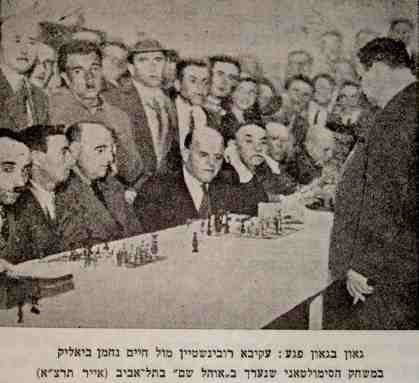
From Miquel Artigas (Sabadell, Spain):
‘I am writing regarding a book published by Ediciones Altosa in 1999 to introduce you to a new chess author: Garry Kaspartov.’
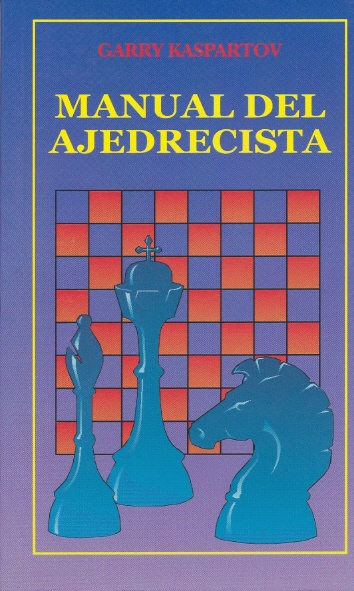
Complementing the earlier items on the famous game of living chess between Capablanca and Herman Steiner in Los Angeles on 11 April 1933, we quote from local reports.
A feature about the Cuban on page 3 of the California magazine The Chess Reporter, April 1933 commented:
‘The chess public of Southern California owe a hearty vote of thanks to Judge Lippman of Santa Monica for his hospitality in entertaining Señor Capablanca and thus making possible the Exhibition and the “Living Chess” on Tuesday night and the receptions to the Masters at the various clubs.’
No further details were given, but the game-score and other information were provided by Clif Sherwood in his chess column in the Los Angeles Times of 16 April 1933, part III, page 7:
‘Former World Champion José Capablanca of Cuba gave his first exhibition at the Los Angeles Athletic Club, playing 32 boards, with 25 wins, six draws and one loss to Allen and Carlson in consultation. Tuesday night the Cuban opposed Herman Steiner, local expert, at the Athletic Club in a game with living pieces in costume, Cecil B. deMille refereeing. Capablanca showed his class in the most brilliant fashion.’
As noted in C.N. 2037, a decade later Steiner reported that the game had been pre-arranged. For the record, we quote, from page 66 of the March 1943 Chess Review, the full text of his letter on the subject:
‘In The Immortal Games of Capablanca, page 203, the introduction to Exhibition Game No. 93 states that this game “played with ‘living pieces’ turns out to be vastly entertaining and must have delighted the spectators”. This gives the impression that the game was played on its merits, when in reality it was pre-arranged by Capablanca, who at that time refused to play any other way. Naturally, I would like this known as it could not possibly be considered an Immortal Game.
Had Mr Reinfeld consulted me before going to press I would gladly have given him all the facts with proof thereof.’
The montage below was presented to us by Olga Capablanca Clark in 1987:
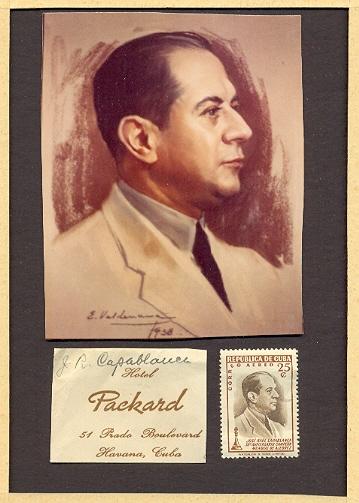
From page 93 of An illustrated Dictionary of Chess by Edward R. Brace (London, 1977):
‘In one game at the Haifa 1976 Chess Olympiad an en passant capture was made two moves after the advance of the enemy pawn. The illegality went unnoticed both by players and arbiters and was discovered only after the conclusion of the game. This is the only recorded instance of an “en passant deferred”.’
Can a reader provide more information?
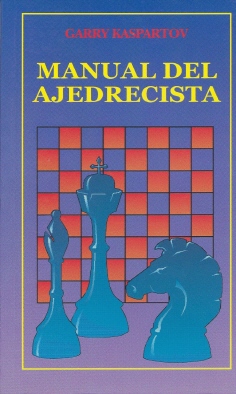
The question that arises regarding the Manual del ajedrecista by Garry Kaspartov is whether ‘Kaspartov’ is an accidental misspelling in a book genuinely by Kasparov or a piece of mercantile trickery by the publisher to exploit the former world champion’s name.
Our correspondent, Miquel Artigas (Sabadell, Spain), has provided further information about the book:
‘There is no mention of an original edition or translator. Nor, in the book’s contents, does Kasparov’s name appear. It is an instructional work (128 pages) with the following chapters:
“Prólogo
I. El tablero y sus fichas
II. El poder de las piezas del juego
III. Las veintiséis reglas del ajedrez
IV. El enroque
V. El valor de las piezas
VI. Fases de la partida
VII. Ejemplo de partida
VIII. El jaque mate
IX. Las anotaciones
X. Los signos
XI. La promoción del Peón
XII. La oposición
XIII. Las Tablas
XIV. Técnicas de apertura
XV.La Celada
XVI. Consejos
XVII. Términos mas usados.”In my opinion the book is badly written and very weak from the technical point of view. It is also full of old-fashioned concepts:
Capítulo III. Regla 3ª (p. 29): “Si se ha empezado una partida con una pieza de menos habiéndose efectuado la cuarta jugada de ambas partes, será obligatorio acabar la partida sin poder colocar la pieza olvidada en su lugar correspondiente.” [If a game has been begun with a piece missing and both players have made their fourth moves, it shall be obligatory to complete the game without being able to put the forgotten piece at its appropriate place.]
Regla 17ª (p. 32): “El que da de ventaja una torre, puede igualmente enrocar del lado en que falta esta torre diciendo: enroco.” [The player giving the odds of a rook may also castle on the side where this rook has been removed, saying: I castle.]
Capítulo XVI. Consejos (p. 121): “Tenemos que procurar hacer el enroque lo antes posible y siempre antes de las ocho primeras jugadas, siendo este síntoma ideal.” [We must manage to castle as early as possible and always within the first eight moves, this being the ideal method.]’
The publisher, Ediciones Altosa, Madrid, has some serious explaining to do.
Miquel Artigas (Sabadell, Spain) supplies some sample pages from the Kaspartov book currently under scrutiny:
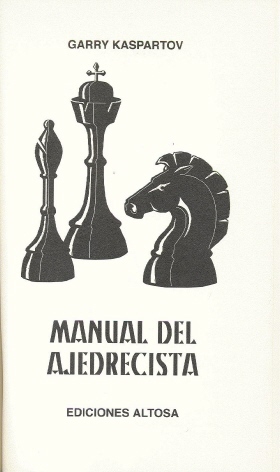


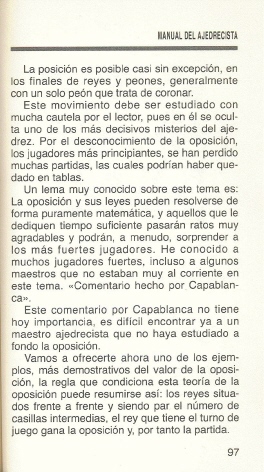
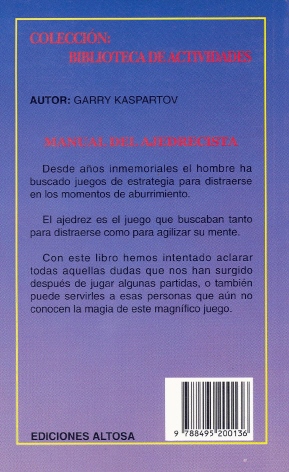
Before presenting an interesting discovery by Christian Sánchez (Rosario, Argentina) we summarize what appeared in C.N.s 325 and 1063 (see page 182 of Chess Explorations) and C.N. 3160 (see page 246 of Chess Facts and Fables).
Rudolf Spielmann has been quoted in chess books as declaring:
‘In the opening a master should play like a book, in the mid-game he should play like a magician, in the ending he should play like a machine.’
In C.N. 325 we asked if Spielmann was really the originator of this observation, and in C.N. 1063 we suggested that the lay-out of the chapter of epigrams in Chernev’s book The Bright Side of Chess (Philadelphia, 1948) had misled writers into thinking that the quote was Spielmann’s. C.N. 3160 reproduced page 107 of Chernev’s book ...
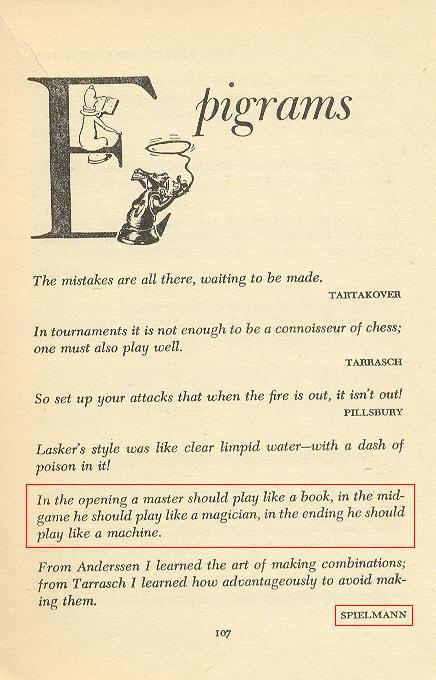
... and we remarked:
‘It is evident from other parts of that chapter of Chernev’s that when he gave, for instance, two unattributed quotations followed by an attributed one it was only the last of these that he intended to ascribe to the writer named. Thus in the extract reproduced above the “poison” quote has no more to do with Spielmann than does the “book, magician and machine” comment.’
What we still lacked, however, was a source for the quote, and that is what Mr Sánchez has now found. He cites the following passage (from the pre-Spielmann era) in the section on Pillsbury on page xiv of The Games of the St Petersburg Tournament 1895-96 by J. Mason and W.H.K. Pollock (Leeds, 1896):
‘A great player was once asked to give his ideas as to how a master ought to play. “In the opening”, was his reply, “a master should play like a book; in the mid-game he should play like a magician; in the ending he should play like a machine.’
In the light of C.N. 4156 we have renewed hope that a convincing (non-Capablanca) source will be found for the ‘conferred sight’ quote so frequently attributed to the Cuban. (See page 182 of Chess Explorations, page 246 of Chess Facts and Fables and C.N. 3741.)
Michael Clapham (Ipswich, England) provides the following additional information:
‘Chess (no author named), a work published by J. & R. Maxwell, London in (possibly) 1886), is not mentioned in Betts’ Bibliography. A 32-page booklet, it is No. 12 in the series of British Standard Handbooks and is a basic primer on the game, also including six problems and a poem entitled “Which is the best indoor game?”.
I can also report that the magazine Junior Chess (Betts 7-119) ran from January 1949 until at least December 1951, with issues as follows: No. 1 January 1949; No. 2 March 1949; No. 3 May 1949; No. 4 July 1949; No. 5 September 1949; No. 6 November 1949; No. 7 Unknown; No. 8 Unknown; No. 9 January-February 1951; No. 10 September 1951; No. 11 December 1951. The December 1951 magazine promised three issues for 1952, in March, September and December.
Another book of interest to chess book collectors is The Popular Recreator, A Key to Indoor and Outdoor Amusements, Volumes I & II, published by Cassell, Petter & Galpin, London in 1873 and 1874. This has 11 articles on chess by John Wisker, “The English Champion”. They mainly consist of general instruction, but there are also items on Kempelen’s automaton, morals, time, laws, tournaments from 1851 to 1873 and a few games. Wisker did not write any chess books of his own, although he edited a number of columns in periodicals. An added attraction of this book is that the articles on draughts and whist (with occasional mentions of Deschapelles) are by the chess authors G.F. Pardon and R.B. Wormald respectively. There are also numerous articles by a James Mason on such amusements as round games, kite-making, toy games, tops and forfeits, but I do not think that this is our James Mason.’
The game below is taken from pages 83-86 of volume one of Manual de ajedrez by José Paluzíe y Lucena (Barcelona, 1905):
J. Víctor – José María Baquero1 e4 e5 2 Nf3 Nc6 3 Bb5 Nf6 4 O-O Nxe4 5 Re1 Nd6 6 Bxc6 bxc6 7 Rxe5+ Be7 8 Qe2 f6 9 Rh5 Nf7 10 Nd4 Ne5 11 Nf5 O-O 12 Rh4 d5 13 Nxe7+ Qxe7 14 Qh5 Qd7 15 Qxh7+ Kf7 16 Qh5+ Ng6 17 Rd4 Qd6 18 g3 Rh8 19 Qe2 c5 20 Ra4 Bd7 21 Ra3 Ne5 22 f3 Rae8 23 Qf2 d4 24 d3
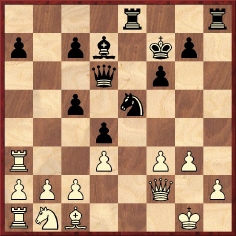
24...Rxh2 25 Kxh2 Ng4+ 26 fxg4 Bc6 27 Bh6 Rh8 28 g5 Qd5 29 g4 Rxh6+ 30 gxh6 Qh1+ 31 Kg3
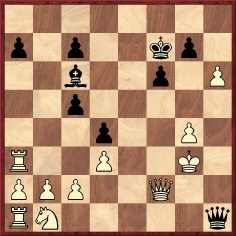
31...g5 32 White resigns.
A few complimentary remarks ascribed to Tarrasch were included in the annotations, these being from the notes published on pages 241-242 of the August 1897 Deutsche Schachzeitung (of which Tarrasch was then the editor). Moreover, the German magazine dated the game 1896 and misnamed Black as ‘Boquero’. As noted on page 22 of Paluzíe’s book, J.M. Baquero, who died prematurely in 1905, was a strong Barcelona player.
From page ix of The Games of the St Petersburg Tournament 1895-96 by J. Mason and W.H.K. Pollock (Leeds, 1896):
‘Steinitz himself, in the Figaro, so far back as 1878 – when he was contemplating retiring from chess – claims that his record was then better than Morphy’s, but left the question of genius an open one.’
This quote is of interest on two fronts. What more is known about Steinitz’s contemplation of retirement in 1878, and what exactly did he write that year about Morphy?
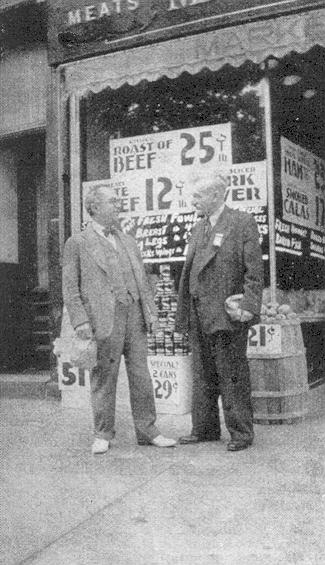
Pages 185-186 of the February 1908 issue of Lasker’s Chess Magazine quoted R.J. Buckley in the Manchester City News:
‘Where is the chessplayer who has not had his fit of chess blindness? Did not William Steinitz print a new defence to the King’s Gambit, backed by two columns of analysis, when in the early stages the defence was smashable by a mate in two? Did not Dr Tarrasch announce a deep, deep mate in five, when the mate could have been made on the move? ... Did not the 16 judges of an international problem tourney throw out the great three-er of Kohtz and Kockelkorn on an alleged cook, when in reality there was no cook at all? Did not the Hastings International Committee award first prize to Professor Benyon’s three-er, which was promptly cooked by a small boy? And did not the [Gazzetta Letteraria] award first prize to a two-er which had no solution at all?’
Particulars will be welcomed on all the above questions.
Russell Miller (Chelan, WA, USA) quotes from page 169 of the Brooklyn Chess Chronicle, 15 July 1883:
‘The Glasgow Herald furnishes the following intelligence: “Some important results are likely to spring from the positions occupied in the International Tourney by the ultimate prize winners. We understand that Steinitz is about to challenge Zukertort to play a match for the sum of £300 to £500 and the championship of the world, and it is the opinion of some who are in a position to judge of the matter that the match will come off.”’
Noting that Zukertort was reported by the Brooklyn Chess Chronicle to have turned down the match because he intended ‘to make a year’s tour’, our correspondent asks if Steinitz called himself world champion at that time.
Steinitz’s proposal of a match was reported on page 323 of the July 1883 Chess Monthly (edited by Hoffer and Zukertort):
‘Mr Steinitz has authorized Mr Steel to communicate with Mr Minchin with reference to a match which he seems willing to play with Mr Zukertort. The conditions are £200 a side or more if agreeable; the match to consist of eight or ten games; three or four games to be played a week; £50 to be deposited as forfeit money; and play to commence between October and January. Mr Zukertort has authorized Mr Minchin to reply to Mr Steel that he cannot make arrangements for a match at such a remote future.’
This does not seem an altogether fair reflection of Robert Steel’s letter to Minchin (dated 24 June 1883, the day after the London, 1883 tournament ended), which was published on page 42 of the Chess Player’s Chronicle, 11 July 1883:
‘... The following are the conditions for the match suggested by Mr Steinitz. If they be approved by Mr Zukertort, any minor conditions may be easily arranged.
1. That the winner of the first eight or ten games be the victor.
2. That the games be played under a time-limit of 15 moves per hour.
3. That play shall be carried on either three days or four days per week, as Mr Zukertort prefers.
4. That Mr Steinitz will accept any suggestion of Mr Zukertort’s as to the hour of the day when play shall commence.
5. That the time for commencement of the match shall be fixed for any date between 1 October and 1 January, which may best suit Mr Zukertort.
6. That the stakes be for any sum not less than £200 a side which Mr Zukertort prefers.
7. That the games shall be the property of both players.Mr Steinitz is of opinion that the contest should, in the interest of both players, take place in a private room, and that admission should be allowed to friends of both parties.
Mr Steinitz is prepared to make an immediate deposit of £50, to bind a match on the basis herein suggested.’
Minchin’s reply to Steel, dated 27 June 1883, was given on the following page of the Chronicle:
‘... [Zukertort] begs me to point out to you that owing to his health and avocations he has always, as Mr Steinitz is aware, refused to bind himself down to play a match of chess at any future period. He cannot, therefore, now accept the conditions offered of binding himself to play at any time between October and January next. As a fact, I fear that Dr Zukertort will not be in England at that period, as I believe he purports starting almost immediately on a protracted tour round the world.
I have no doubt that on his return from this tour Dr Zukertort will be quite ready to make a match with Mr Steinitz on reasonable conditions, such as those offered, to promote which, when the time arrives, I shall be happy to use my good offices.’
It will be noted that no reference to the world championship occurred in these exchanges. However, it was evoked in a follow-up item in the next issue of the Chronicle (18 July 1883, page 50). We quoted it in full in C.N. 3750.
It is not easy to reconcile the captions to the following two illustrations, which appeared respectively on page 159 of David Lawson’s biography of Morphy and on page 173 of “Our Folder” (the Good Companion Chess Problem Club), 1 May 1921:
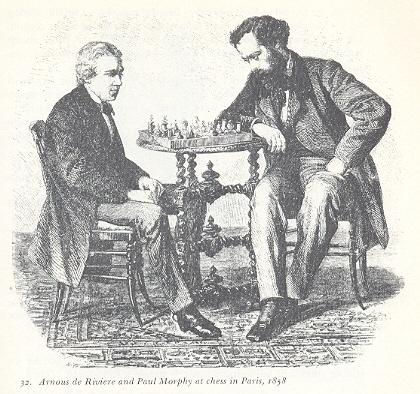
‘Arnous de Rivière and Paul Morphy at chess in Paris, 1858’
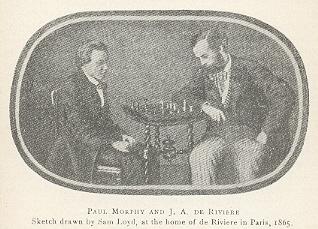
‘Paul Morphy and J.A. de
Rivière.
Sketch drawn by Sam Loyd, at the home of de Rivière in Paris,
1865’
One extra complication is the question of whether ‘1865’ was a misprint for 1863.
Page 622 of the Literary Digest, 19 May 1900 gave the following extracts from an article by Pillsbury in The Independent of 10 May that year:
‘Perhaps the mental quality most useful to the chessplayer who wishes to rise to distinction in the game is concentration – the ability to isolate himself from the whole world and live for the events of the board while a match is proceeding. And yet “concentration” does not quite suit me as expressing the quality I refer to, for concentration implies narrowing, and I am satisfied that the influence of chess broadens the mind.
Besides the quality which we have, for want of a better name, called concentration, there are others that are essential to the good chessplayer. One of these is patience, or ability to wait. We have players who are known as plungers, who see an opening and drive ahead into it without studying out all that it leads to. Such men can never become good players. The chessmaster must have full control of himself at all times. He must not be impatient, he must be content to mark time, as it were, till he sees the result of his opponent’s attack, and he must be able to resort to meaningless moves to kill time if there is no other way of holding fast to the fortified position till the danger is over. Not all men can do this. They want to rush out and attack, and thereby they expose themselves and lose the game.
Another most useful quality is accuracy, in which Lasker excels. His foresight has not so great a range as that of Chigorin, for instance, but so far as he sees he is infallible. Chigorin may see five moves ahead and Lasker only three, but the latter more than evens up matters by his deadly accuracy and thoroughness.’

This is Arnoldo Ellerman (1893-1969) in a photograph culled from page 120 of “Our Folder” (the Good Companion Chess Problem Club), 1 February 1921. Michael McDowell (Westcliff-on-sea, England) points out that it had previously been published on page 157 of 100 Chess Problems by William Meredith 1835-1903, the 1916 volume in the A.C. White Christmas series. Below is a portrait of Ellerman from page 43 of the 1922 issue of Chess Pie:
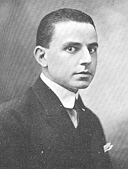

Since writing C.N. 3760 we have acquired a further slightly different edition (the fourth) of B. Scriven’s 1930s book Chess and How to Play It, although the text itself is, alas, still the same. This work has already been referred to several times (see under ‘Scriven’ in the Factfinder), but there is no let-up in the quotable gems. Here, for instance, are two ‘rules’ from page 48:
‘If the king is checked, but “check” is not announced, the owner of the king need not attend to it. Though there is no rule on the subject, it is usual to announce “check” when the queen is affected.
If “check” is announced and the owner of the king proceeds to move the king, then realizes that there was no “check” he may take back the move. The same applies if any other piece is moved for the purpose.’
Page 62 has a game which ‘offers many features of special interest’ (such as the author’s presentation of an imaginary mate):
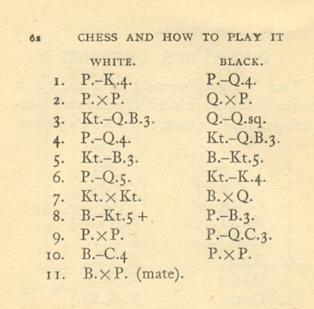
One of our copies of Capablanca’s Chess Fundamentals was formerly owned by a figure who learned the game in Switzerland, attended a boarding school in Italy and played chess for Oxford University. His travels also included military service in Ljubljana. As a chess organizer he was involved in one of the greatest of all tournaments, and in the book on the event. He edited a chess column in a newspaper whose earlier columnist was a world champion, and for a famous book by that world champion he compiled the index. Who was he?
The following game, from the Sheffield Independent, was published on page 303 of the Chess Player’s Chronicle, 20 February 1884 and on page 154 of Chess Fruits by T.B. Rowland and F.F. Rowland (Dublin, 1884):
St Valentine – St Benedict1 e4 e5 2 Nf3 Nc6 3 Bc4 h6 4 d4 Nf6 5 Nc3 Na5 6 Nxe5 Nxc4 7 Nxc4 d5 8 Ne5 dxe4 9 O-O Bf5 10 Re1 c5 11 f3 cxd4 12 fxe4 Bc5 13 Nd5 Nxe4 14 Qf3 g6

15 Rxe4 Qxd5 16 Nxg6+ Bxe4 17 Qf6 d3+ 18 Kf1 Bxg2+ 19 Ke1 Qe4+ 20 Kd2 Bb4+ 21 c3 Qe2 mate.
From a letter about Emanuel Lasker contributed by Heinrich Fraenkel to CHESS, 20 June 1957, page 230:
‘Whoever told you about “his chronic insolvency” can’t have known Lasker. True enough, he was desperately poor in his youth (and so was brother Berthold, later to be a famous Professor and head of a fashionable clinic); but ever since the early and mid-nineties Lasker’s considerable earnings were much in excess of his requirements; to say nothing of the fact that his wife Martha (daughter of one of the wealthiest bankers in Berlin) was a very well-to-do woman. It was only after 1933 – when the Laskers had to emigrate, leaving their large flat in Berlin’s West End, their country cottage and their bank accounts behind – that the old man had to resume working for a living. But for financial reasons, it is almost certain that he wouldn’t have played at Zurich, Moscow or Nottingham. Hence, so far as chess history and chess literature is concerned, it was certainly a blessing in disguise, however deplorable the thought that so great a man, in his declining years, should have been exposed to financial worries.’
C.N. 4162 quoted R.J. Buckley as writing, ‘Did not William Steinitz print a new defence to the King’s Gambit, backed by two columns of analysis, when in the early stages the defence was smashable by a mate in two?’
Michael Alderson (Derby, England) now draws attention to the following broadly similar story (albeit about a different opening) by Irving Chernev on page 322 of the July 1976 CHESS:
‘Back in the days when William Steinitz was Champion of the World, he published a lengthy analysis of a defence which he considered to be a refutation of the Evans Gambit. It took up pages of print in his publication The International Chess Magazine, and impressed layman and expert alike. Steinitz was interviewed by the press and referred to by them as the destroyer of the gambit.
The line he advocated ran as follows: 1 e4 e5 2 Nf3 Nc6 3 Bc4 Bc5 4 b4 Bxb4 5 c3 Ba5 6 d4 exd4 7 O-O Nf6 8 Ba3 Nxe4 9 Qb3 Ng5.
This position is reached:
Steinitz’s adopted daughter glanced at the position, and smashed the whole line by asking why White should not play 10 Bxf7+ Nxf7 11 Re1+, winning the queen.
This two-move win almost broke Steinitz’s heart, as he was subjected afterwards to a great deal of disparaging comment.’
But how much truth is there in all that? We quote from pages 297-298 of the July 1895 BCM an item reproduced from the New Orleans Times-Democrat:
‘A Discovery in Chess. About as amusing an event as has marked chess history for some time past has recently occurred in New York, and our esteemed contemporary, the New York Sun, was, in one sense at least, the victim involved. In its issue of the second instant (2 June) appeared an article nearly a column in length, introduced with the startling headlines, “Great Discovery in Chess”, “Steinitz finds the Death Blow for the Evans Gambit”, “Like Many Great Discoveries, It Comes by Accident from an Unexpected Source”, etc., etc., with the portentous announcement, “Copyright by W. Steinitz”. Nor was a perusal of the article calculated to diminish the excitement. The main portion thereof, introduced with a delightfully playful exuberance by the chess editor of the Sun, was as follows:
Now comes Champion Steinitz again with the statement that at last he has found the key, and that he has discovered the move that will make all Evans Gambit players bite the dust. He regards it as the most sensational discovery in chess since that of Capt. Evans himself, and greater than that inasmuch as it proves to be the latter’s master.
The discovery was accidental by Mr Steinitz’s adopted daughter. How it was made is here told by the champion.
“My niece and adopted daughter, Miss Hedwig Steinitz”, said Mr Steinitz, “was trying to play over from memory the well-known Suhle attack in the Evans Gambit and arrived correctly, after the moves 1 e4 e5 2 Nf3 Nc6 3 Bc4 Bc5 4 b4 Bxb4 5 c3 Ba5 6 d4 exd4 7 O-O Nf6 8 Ba3 Nxe4 9 Qb3, at the position marked on the diagram below.
‘Papa’, she said, ‘is this the move now?’ and she pointed to ...Ng5 for Black.
No doubt my daughter saw no more than that she defended the twice-attacked f-pawn, and she even overlooked that the protection only lasted for one move, as White could capture the knight. But what an analytical revelation opened itself before my eyes. And, of course, any modern expert will see at a glance that this is the right move, which has been overlooked by all analysts and practioners [sic] for about 35 years.
‘The previous question’ will have to be moved in regard to the soundness of the Evans Gambit, and we have to fall back to find another answer to 7...Nf6.”
But singular to relate, “analysts all over the world” did not “move the previous question” in regard to the soundness of the Evans, nor did they “start for the discovery of new lines of play” in the gambit. They simply took hold of the particularly extraordinary variation propounded by Steinitz and they suggested that he had actually overlooked a deep two-move combination continuing 9...Ng5 10 Bxf7+ Nxf7 11 Re1+ and wins in a canter. And the ex-champion himself writes a letter to the Sun of 5 June acknowledging his “great discovery” to be no discovery at all; that his analysis was unsound. And the Sun (in its sub-editorial columns) sagely remarks: “So the Evans Gambit holds its ground. This delusion of Steinitz shows how genius can often be inferior to the dispassionate calmness of understanding comparatively common-place.’
We should firstly like to be reassured that the above account from the New Orleans Times-Democrat (whose chess editor was a foe of Steinitz, James Séguin) accurately reflects what appeared in the New York Sun. At any rate, it is certainly a far cry from Chernev’s account.
Further to our Fischer’s Fury article, it is worth noting that in the feature referred to in the preceding item (CHESS, July 1976, pages 322-323) Irving Chernev also discussed the Fischer v Bolbochán game and pointed out the non-existent mate:

The note remained the same in the 1994 (algebraic) edition of Modern Chess Brilliancies.
Michael Syngros (Amarousion, Greece) provides the following list of books by Joaquim Monteiro Valladão, from pages 11-12 of his Glossário Caissiano (Rio de Janiero, 1961):
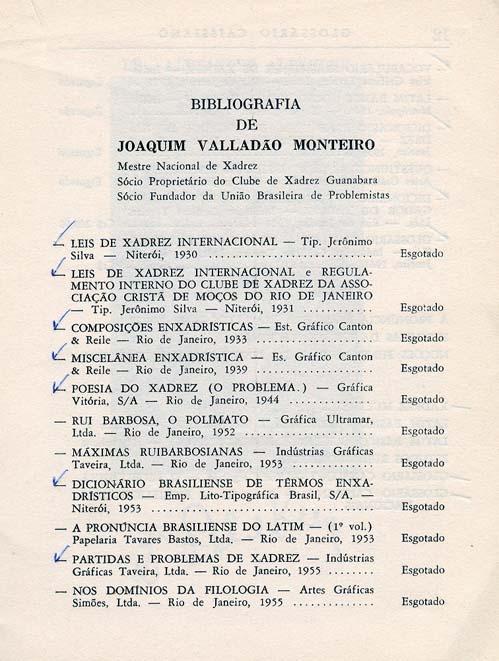

The blue marks above have no significance. If readers can help us to acquire any of these works, we shall be most grateful.
In C.N. 3194 (see pages 280-281 of Chess Facts and Fables) a correspondent mentioned a report in Alexander Münninghoff’s book on Max Euwe (pages 155-156 of the Dutch original and page 112 of the English edition) that in 1935 Euwe played, while preparing to face Alekhine for the world championship, a secret ten-game match against Spielmann. Below is Münninghoff’s text:
‘… just before the final secondary school exams he met Spielmann for a drawing-room match. This latter piece of practical training went quite badly for him; we don’t know whether he found it hard to concentrate because of his schoolwork or whether he had underestimated Spielmann, who was clearly past his prime as a chessplayer, but the fact remains that the peripatetic Austrian veteran claimed this secret ten-game match in fairly superior style with 6-4 (+4 –2 =4).’
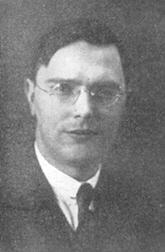
Max Euwe
Alan McGowan (Waterloo, Canada) quotes three reports from 1935 which show that the existence of the match was not a secret and that, moreover, there is no unanimity as to who won the contest:
1) From page 402 of the September 1935 BCM:
‘In preparation for his match for the world championship, Dr Max Euwe has had a practice match with R. Spielmann, whom he beat by 4-2, with 2 draws.’
2) Pages 282-283 of Deutsche Schachblätter, 15 September 1935 also referred to the Euwe v Spielmann match, without giving the result:
‘Der holländische Vorkämpfer nimmt den Kampf sehr ernst; so hat er sich in Trainingskämpfen mit Spielmann und Eliskases geschult und in Wien theoretische Studien getrieben.’
3) The December 1935 Wiener Schachzeitung had an article reviewing the past year, and on page 354 it was stated that Spielmann had defeated Euwe:
‘... in einem Übungswettkampf schlug er Euwe 4:2 ...’
We can add that in De Groene Amsterdammer (an article reproduced on pages 185-186 of the June 1935 Tijdschrift van den Nederlandschen Schaakbond) Salo Landau wrote that Euwe and Spielmann were playing a training match in the absence of the press and witnesses, so that Alekhine would not have the benefit of seeing the games:
‘Het is bekend, dat Euwe op het oogenblik een oefenmatch speelt met Spielmann. Pers noch toeschouwers worden hierbij toegelaten, uit vrees, dat Aljechin de partijen te zien zal krijgen en daardoor het geheim der vorderingen van den Nederlandschen kampioen te weten zou komen.’
Can readers shed further light on the Euwe v Spielmann match?
A light game which is seldom if ever seen nowadays:
José Tolosa y Carreras – J.C. Batlle1 e4 e5 2 Nc3 Nf6 3 f4 Bb4 4 Bc4 Bxc3 5 bxc3 d5 6 exd5 Nxd5 7 Qf3 Nxf4 8 Ba3 Nxg2+ 9 Qxg2 Qh4+ 10 Qg3 Qxc4 11 Qxg7 Qe4+ 12 Kf2 Qxh1 13 Nf3 Qxa1 14 Qxh8+ Kd7 15 Nxe5+ Ke6 16 Qe8+ Kd5 17 Qxf7+ Be6 18 Qf3+ Kxe5

19 d4 mate.
Source: volume one of Manual de ajedrez by José Paluzíe y Lucena (Barcelona, 1905), page 130.
Mark N. Taylor (Mt Berry, GA, USA) writes:
‘I have recently acquired a copy of Shakespeare’s King Richard II, with illustrations by Isadore Seltzer (New York, 1975). Twenty full-page illustrations all have chess themes, even though there is no chess in the play itself.’
A sample provided by our correspondent is given below:

From the Salo Flohr entry on page 139 of The Encyclopaedia of Chess by Anne Sunnucks (London, 1970):
‘In Czechoslovakia he became a national hero, and Salo Flohr collars, Flohr slippers, Flohr cigarettes and Flohr eau-de-Cologne appeared on the market.’
This relates to the 1930s, but what hard facts exist about such merchandising?
Further to C.N. 3231 we are still keen to find out whether the 1926 game between F.W. Viney and H.F. Gook is the only instance on record of a king suffering a smothered mate when surrounded by a full set of eight ‘friendly’ units:
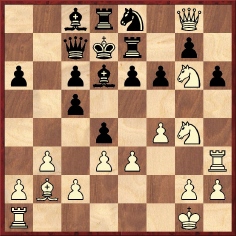
25 Nf8 mate.
The game was published on page 100 of 1 P-KB4 (A Guide to
Bird’s Opening) by R.E. Robinson (Liverpool, 1950), but we
now note that in our item on pages 56-57 of Chess Facts and
Fables White’s name was given as Vine instead of Viney.
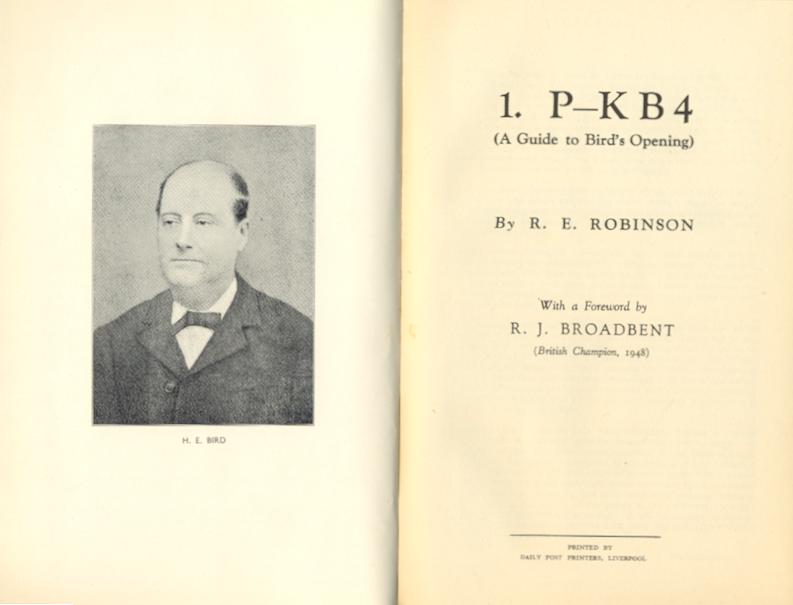
On page 13 of his introduction Robinson wrote:
‘The hitherto unpublished photograph of Bird which forms the frontispiece has been reproduced from an original photograph kindly sent to me for the purpose by the Rev. H.E. Bird of Southsea, a nephew of the Master.’
We wonder who first articulated the well-known advice that a flank attack is best met by play in the centre. Would any reader care to open the bidding?
Calle Erlandsson (Lund, Sweden) sends the following nine postcards:
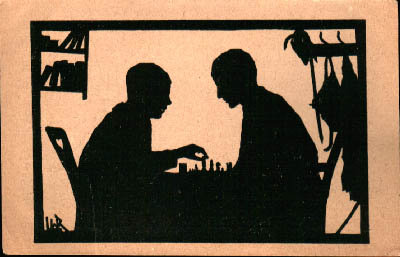
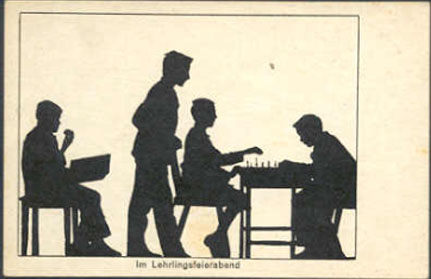
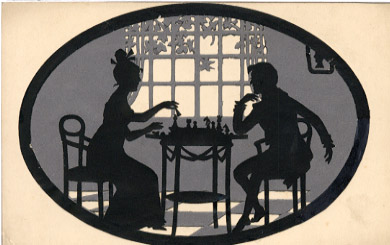
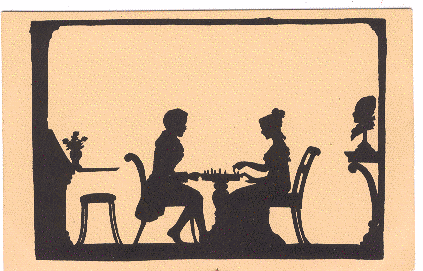
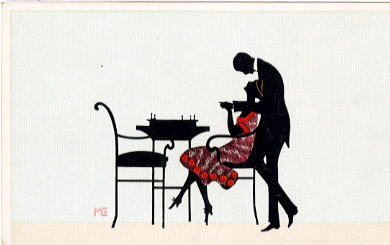
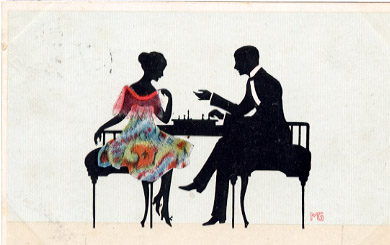
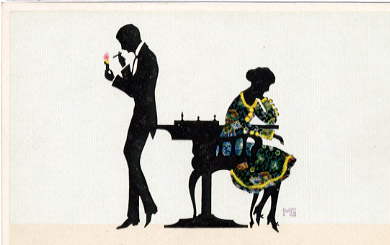
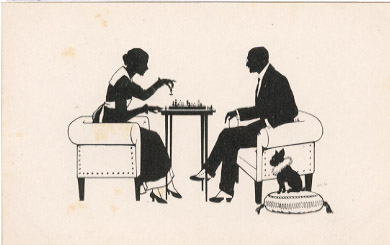
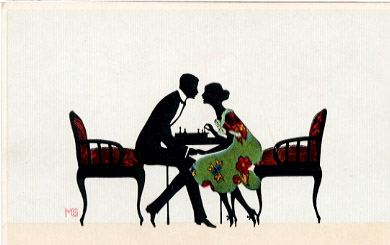
The prodigy pictured in C.N. 4134 was Anthony John Taffs, the photograph having appeared on page 153 of the May 1930 issue of The Gambit, which called him ‘a young genius of chess’.

His 1981 book Chess Cabala was discussed in C.N. 303, and below we give a composition of his published on page 199 of The Gambit, July 1930:
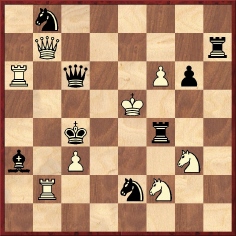
‘Composed for and dedicated to Mr A.J. Souweine, New York.
The Four-fold Letter Problem Forms the Initials A.J.S.
Either White or Black mates or self-mates in two moves.’
This group photograph appeared on page 19 of The Gambit, April-May 1931, the occasion being the Philadelphia v London cable match on 21 March 1931:
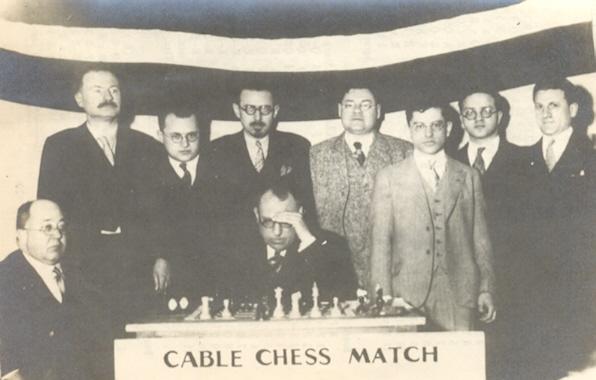
From Andrew Smith (Bourne End, England):
‘I am looking for games played by a former chess club colleague, Ted Mason, who was active in the Kent area from the 1930s to the 1960s. He also used to play in the Gambit Café in London, had a unique playing style and won some quite brilliant games. He died in the 1980s, aged around 90.’
‘My favorite chess writer’ is how Andrew Soltis described D.J. Morgan in a good article on pages 8-9 of Chess Life, June 1983 which was reproduced, under the title ‘Master of His Craft’, on pages 166-170 of Soltis’ book Karl Marx Plays Chess (New York, 1991).
An eminent writer who paid tribute to Morgan was G.H. Diggle, and below we reproduce his words (originally printed in the July 1978 Newsflash) from page 36 of a compilation of his articles published by us, Chess Characters (Geneva, 1984):
‘The late D.J. Morgan, who died on 13 May – the day after his 84th birthday – called himself “a mere hotchpot corner filler in the BCM”. There is perhaps a grain of truth in this estimate, for profound as was his knowledge of chess and its history from every angle and brilliantly as he could write when he chose to compose a set piece (as for example his classic article on the BCM’s 75th Anniversary) it is for “Quotes and Queries” that he will always be best remembered.
He opened his weird chess supermarket in the BCM of March 1953 with the following words: “We offer brief replies to queries of general interest on any aspect of the game. When we fail we will appeal to readers!” The only “goods” he would not touch were the three awkward “A’s”, analysis, annotations and adjudications. He had a boyish love for Guinness Book of Records chess items, and would order his readers out on research sprees and sometimes wild goose chases. “Come on”, he would bully them, “what is the record for castling in Master Chess?” (The BM timidly suggested Steinitz (on his 32nd move) in a match game v Zukertort, 1886, only to be demolished by R.W.B. Clarke, who unearthed Yates (on his 36th move) against Alekhine (San Remo, 1930). Still more exciting was a “Lingering Pawn” investigation in which it was discovered that in a Championship Match game against Lasker, Schlechter’s King’s Pawn remained stationary for 71 moves on its own square, whilst in Gottschall v Tarrasch (Nuremberg, 1888) the parsimonious Doctor kept all his pawns until the 69th move, the game ending on the 100th with his QRP still at its base.
His resource in repartee never flagged, and he was a supreme chess “ad libber”. To a querist who wrote in and said rather cryptically, “I first judge a problem by counting the number of pieces in it” D.J.M replied, “You doubtless first judge a novel by counting the number of words in it.” Q. “I have seen no problem lately by W... Has he been composing in recent years?” A. “Alas! He has been decomposing since 1934.” Q. “I find it extremely difficult to get boys interested in chess books?” A. “Have you tried labelling them ‘For adults only’?” “Chess Champions”, D.J.M. once informed a correspondent – during the lean pre-Fischer era – “are born not paid”. Occasionally he could be cutting: “The author in question is more of a pedlar than a pioneer. You must not confuse aspiration with inspiration.”
He “reigned” for just 25 years (and 3,932 “quotes”) over a vast expanse of loyal and grateful subjects of every land and every nationality. “We shall not look on his like again.”’
Nicolas Sphicas (Thessaloníki, Greece) draws our attention to a large number of paintings by him with a chess theme.
From Russell Miller (Chelan, WA, USA) we have received the notice in the ‘Albion College News’ regarding A.J. Taffs’ death in Marshall, MI, USA on 4 February 2005, at the age of 89.
We have now found the following by George Koltanowski on page 440 of CHESS, 14 August 1936:
‘Prague has Salo Flohr collars, Flohr slippers, Flohr cigarettes (he is a non-smoker, too!), Flohr eau-de-Cologne, etc.’
Koltanowski wrote similarly about Flohr on pages 54-55 of his book “En Passant” Chess Games and Studies (Edinburgh, 1937):
‘If you happen to stroll round Prague, a look at the various shop displays will give striking evidence of his fame. Here can be seen Flohr collars, Flohr slippers, Flohr Eau de Cologne, and (although he is a non-smoker himself), Flohr cigarettes, and so on.’
Wanted: corroboration of this in a dependable source.
C.N. 4175 gave, from a 1905 Spanish book, a short game between José Tolosa y Carreras and J.C. Batlle, with no venue or date available.
Graham Clayton (South Windsor, NSW, Australia) points out that when the score appeared on page 334 of 1000 Best Short Games of Chess by Irving Chernev (New York, 1955) the occasion was given as Barcelona, 1898. The players’ names were rendered as ‘Carreras’ and ‘Battle’.
In C.N. 2051 (see pages 322-323 of Kings, Commoners and Knaves) John Nunn asked which player originally commented that he had never beaten a healthy opponent. Some readers subsequently drew attention to the following assertion by B.H. Wood in the 1949 Illustrated London News which was anthologized on page 10 of The Treasury of Chess Lore by Fred Reinfeld (New York, 1951):
‘It was old Burn, veteran British master of the ’90s, who was heard to remark plaintively towards the end of his long life that he had never had the satisfaction of beating a perfectly healthy opponent.’
The same passage (with a repetition of the word ‘never’) was reproduced by Wood on page 78 of CHESS, January 1952, but it has not been possible to find any link between the quote and Amos Burn.
Now, however, we note that page 2 of Chess Pie, 1936 had an article entitled ‘Humours of Chess’ by E.B. Osborn (‘Literary Editor of the Morning Post’). It concerned H.E. Bird (‘most lovable of all the old masters’), with whom he was personally acquainted. Osborn remarked:
‘Dear Old Bird would say that he had hardly ever beaten a healthy player.’
The question which thus arises is whether B.H. Wood, writing over a decade later, had the Osborn article in mind but mistakenly referred to Burn instead of Bird.
C.N. 4168 set a poser:
‘One of our copies of Capablanca’s Chess Fundamentals was formerly owned by a figure who learned the game in Switzerland, attended a boarding school in Italy and played chess for Oxford University. His travels also included military service in Ljubljana. As a chess organizer he was involved in one of the greatest of all tournaments, and in the book on the event. He edited a chess column in a newspaper whose earlier columnist was a world champion, and for a famous book by that world champion he compiled the index. Who was he?’
The answer is Horace Ransom Bigelow (1898-1980). We took most of the above biographical details from pages 89-96 of Hobbies for Everybody edited by Ruth Lampland (New York, 1934), i.e. Bigelow’s section on chess therein. The great tournament in which he was involved was New York, 1924. The world champion mentioned in our question was Emanuel Lasker, the newspaper being the New York Evening Post. The book whose index he prepared was Lasker’s Manual of Chess (New York, 1927), page 377 of which acknowledged his contribution.
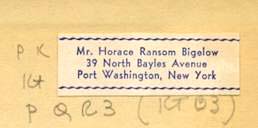
From one of our copies of Chess Fundamentals
This photograph of Bigelow and his son was published on page 7 of the American Chess Bulletin, January 1929:
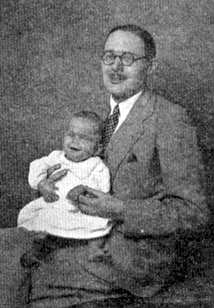
On page 92 of the Hobbies for Everybody chess section mentioned in the preceding item H.R. Bigelow wrote:
‘I learned the moves from a Swiss governess in Lucerne, Switzerland, at the age of ten. For several years afterward I did not even look at a chessboard. Then I met a lad slightly my senior, in a boarding school at Mondragone, Frascati, a few miles outside of Rome.
We played together occasionally in the year I spent there. His superior skill awakened on my part a natural desire to surpass him. (He later became one of Italy’s strongest players and a member of their team in the international team tourneys. His name is Count Antonio Sacconi.)’
Mention of Sacconi, who became champion of Italy in 1935, reminds us of the following extract from an article, if it merits that term, by George Koltanowski entitled ‘Koltanowski, as usual!’ on page 412 of CHESS, 14 July 1936:
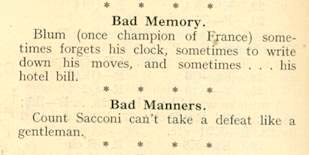
Koltanowski gave no substantiation for his attack on Sacconi, any more than he backed up his assault on the mysterious ‘Blum (once champion of France)’.
As noted on page 228 of Kings, Commoners and Knaves, almost a quarter of the entry on Bogoljubow in The Encyclopaedia of Chess by Anne Sunnucks (London, 1970) was devoted to the well-known anecdote about how the master, beer mug in hand and looking out of place, was cut from a photograph. Sunnucks’ book stated that this had occurred in Switzerland, but other secondary sources were quoted by us which gave Spain and England. We also reported that the story had appeared on page 13 of CHESS (14 September 1935):

That, in fact, is the first appearance recalled by us, and it may be added here that the following year CHESS (14 November 1936, page 85) described it as ‘the joke about Bogoljubow which Koltanowski contributed to the first number of CHESS’.
Was it really no more than a ‘joke’? That is certainly not the impression given by, for instance, Koltanowski’s rifacimento of his story (‘a ten-board simultaneous blindfold exhibition against all the members of a small chess club in Switzerland’) on page 13 of Chessnicdotes 1 (Coraopolis, 1978). Finally, a discrepancy which we are unable to explain is that pages 28-29 of the 1936 edition of Chess Pie comprised an advertisement for CHESS which featured ‘some extracts’ from ‘the magazine that has taken the chess world by storm’. These included the Bogoljubow story but not only in a different wording but even with a switch from Switzerland to Spain:
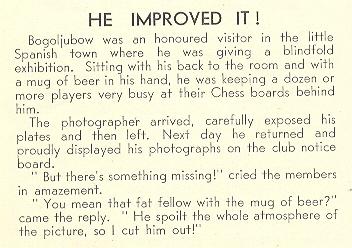
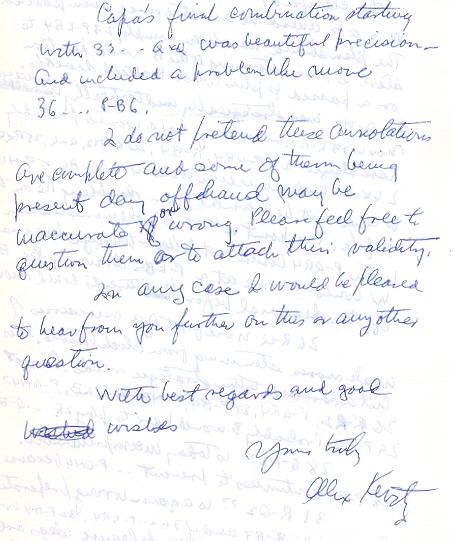
Karsten Müller (Hamburg) writes regarding the famous game Kevitz v Capablanca, New York, 1931, which was discussed in C.N.s 2805 and 2820 (see pages 24-25 of Chess Facts and Fables). The former C.N. item transcribed from our collection a detailed letter about the game from Kevitz to Bruce Hayden which contained this remark:
‘Capa’s final combination starting with 33...QxQ was beautiful precision and included a problem-like move 36...P-B6.’

In C.N. 2820, however, it was mentioned that after 36...f3 White could have played 37 Bf1 Rb8 38 Bd3 Rb2 39 Rxb2 axb2 40 Bb1 Bc4 41 Kg3 Be2 42 a4, with counter-play and only a slightly worse position.
Dr Müller informs us:
‘Capablanca’s 36...f3 was, in fact, a mistake, violating the important endgame principle “do not hurry”. Improving the position of the rook and king first and playing ...f3 later to disrupt White’s defensive coordination should win. For instance, 36...Ra4 37 g5 Kg7 38 h4 h6 39 gxh6+ Kxh6, and White is powerless against Black’s plan of bringing the rook to b2 and infiltrating with the king (e.g. 40 Bf3 Rb4, followed by ...Rb2).’
Below is the exact wording and source of one of the Morganisms (a reply to ‘Roy P.’) cited by G.H. Diggle in the tribute reproduced in C.N. 4184:
‘“I have seen no problems lately by W. Pauly: has he been composing in recent years?” Alas! Poor Pauly has been decomposing since 1934.’
Source: BCM, March 1963, page 81.
David Woolrich (Bolton, England) points out that this repeats a quip (about Bach) widely attributed to W.S. Gilbert (1836-1911).

This picture was published on page 5 of the January-February 1941 American Chess Bulletin under the heading ‘Good Companions’ and with the following caption:
‘Shopping in Hamilton. The last photograph taken of Dr Lasker was this snapshot of him standing outside a market in Hamilton, NY, where he attended the State meeting, 17-24 August 1940. To the lapel of his coat is attached a committeeman’s badge, and in his left hand the veteran carries the inevitable bag of fruit. His vis-à-vis, Harold M. Phillips, wears an expression which shows him to be sensitively attuned to the quizzical good humor of his famous friend.’
The term ‘circumrotatory chess’ appeared on page 130 of the June 1875 City of London Chess Magazine (edited by W.N. Potter), while page 196 of the August 1875 issue had ‘pedaneous chess’. In each case the reference was to a simultaneous display.
Page 49 of The Even More Complete Chess Addict by M. Fox and R. James (London, 1993) had a list of famous writers categorized as chess ‘addicts’. George Orwell was among the names, but why? Characteristically, the book offered no evidence or explanation.
It may be wondered what connections of any kind exist between Orwell and chess. At present, we can put forward only two, and the first is slender in the extreme. Quoted in C.N. 160, the reference below comes from page 249 of George Orwell: A Life by Bernard Crick (Harmondsworth, 1982) and relates to the young Orwell’s part-time employment in a bookshop.
‘Booklovers’ Corner was owned by Francis and Myfanwy Westrope. It is now the Prompt Corner, a chessplayers’ café on the corner of South End Green, Hampstead, but it remained a bookshop until the mid-1950s.’
The second quote appeared on page 101 of King, Queen and Knight by N. Knight and W. Guy (London, 1975), the source being volume one of an Orwell compendium, The Collected Essays, Journalism and Letters edited by Sonia Orwell and Ian Angus. It comes from a letter written by George Orwell to Brenda Salkeld [sic] in March 1935, at which time he was working at Booklovers’ Corner:
‘I have bought an awfully nice set of chessmen – wood not ivory, but they are beautiful big pieces, weighted, and the white ones are real boxwood. The other day my employer was at a house buying books and they offered him these chessmen, and he bought them for a shilling. We were going to put them in the window at ten shillings, but I bought them for seven and six instead. They would cost 30 shillings new, I should say.’
Knight and Guy commented:
‘The passage quoted contains the sole reference to chess in the entire four volumes of The Collected Essays, Journalism and Letters but it should not be deduced from this that George Orwell was not himself interested in the game. It seems more likely that a young man, not over well-off, would snap up the set described for his own use rather than for ornament. With today’s debased currency, a set that would cost 30s in 1935 would cost at least £10 now.’
The amount paid by Orwell for the chess set (7/6, i.e. seven shillings and sixpence) invites comparison with the prices of various new chess books at the time, as stated on the cover pages of the March 1935 BCM:
- How Not to Play Chess by E.A. Znosko-Borovsky: 2/-
- A Primer of Chess by J.R. Capablanca: 10/6
- The Game of Chess by S. Tarrasch: 12/6.
To return to the central question, on what grounds is it stated that George Orwell was a chess addict?
From page 3 of the April 1933 issue of The Chess Reporter:
‘To the historic roster of eminent Masters taking up residence in good old USA must now be added the name of Capablanca.
He told us about it on the 15-mile drive that brought him into Los Angeles the first of the month, following his arrival by SS California from Panama and Cuba. “I am going to live in North America, probably New York City”, said Capablanca. “Among other plans I have incorporated a Chess News Service to furnish syndicate and special service to journals everywhere.”
... Capablanca pulled out a letter from a personal friend, economist he stated of New York’s largest bank, and proceeded to read extracts. He was highly pleased over his financial friend’s prediction that better times are ahead, and seemed particularly glad that New York, the scene of his education and earlier triumph, is his goal.
Strange as it may sound in these modern days, the “social ego” of Capa is absolutely devoid of publicity-hunting, photographs, press-books or ballyhoo ...’
We have no information on the fate of the ‘Chess News Service’ idea.

Below is the early part of an article by John Keeble about Zukertort on pages 401-403 of the October 1927 BCM:
‘His ashes remain in our keeping, as he died in London on 20 June 1888 and was buried in Brompton Cemetery, to the west of the Chapel, and about half-way between it and the Chelsea Football Ground. The grave is officially known as A.F. 107 x 18. A memorial slab, known as a marble “ledger”, is laid on the grave, and bears the following inscription:
“In Memory of J.H. Zukertort, the Chess Master,
Born September 7th, 1842. Died June 20th, 1888.”The slab is in good condition and the lettering still clear, but it has sunk into the ground considerably and wants restoration in that respect.’
We also quote a passage about Harold Lommer from page 12 of Cabbage Heads and Chess Kings by Bruce Hayden (London, 1960):
‘Zukertort became his hero. So, when Harold learned that it was in London he died – he was carried from Simpson’s Divan to Charing Cross Hospital near by – Harold searched the big city for his grave.
He found it, neglected and overgrown with weeds, in a cemetery in Kensington, a genteel quarter. Shocked, he spent two afternoons in clearing and trimming the plot, and since then a fine afternoon is likely to make Harold feel restive. Before long, he is on his way to Kensington with his gardening outfit to keep the grave of the great man in shape. His task done, Harold will sit around in the sun for a while with his pocket set, and some of his best conceptions have come during these moments.’
There is a photograph of the Zukertort plot on page 170 of Der Großmeister aus Lublin by Cezary W. Domański and Tomasz Lissowski (Berlin, 2005) with the caption, ‘Reste der Grabstätte Zukertorts auf dem Friedhof “Brompton” in London (1997)’.
C.N.s 3835 and 3841 gave a group photograph of San Remo, 1930. Here is another one, from page 24 of the February 1930 American Chess Bulletin:

From pages 149-150 of the Literary Digest, 2 February 1901:
‘In a lecture, recently delivered in Chicago, on chess openings, Mr Pillsbury said that in modern practice among the great masters only two openings – the Ruy López and the Queen’s Pawn – are considered to retain the advantage of the first move for any length of time. He believed that the Berlin Defense of the Ruy López was the best. Of the Petroff Defense, which he brought into practise again in the St Petersburg tournament several years ago, he does not now entertain as good an opinion as he did then. He believes if White continues with 3 P-Q4 the advantage remains with the attack, and for that reason he has abandoned it. He agrees entirely with the principles laid down in Lasker’s Common Sense in Chess and says every great master must necessarily do so. Against the Evans Gambit he recommends Lasker’s defense or the refusal of the gambit. In either case the defense should obtain a better game.
He also holds that the Falkbeer Counter-Gambit against the King’s Gambit should yield the second player the superior, or at least equal, game. He dwelt at length on “the waiting move”, claiming there should be no such thing in a correct game of chess. Should a player at any time make an indifferent move like P-R3, simply because he knows of nothing better, there is an admission of weakness in his game. On the other hand, if such a move is made with the pre-conceived plan of making a general advance in the pawn formation, it is then a sign of strength. He is of the opinion that between even players in serious games the attack, with accurate play, should win about two games in ten, the others resulting in draws.’
It may be recalled that D.J. Morgan’s son is the eminent historian Kenneth O. Morgan, now Lord Morgan. We are very grateful to him for sending the following memoir:
‘My father was a most able, quiet man of great modesty. He was born on 11 May 1894 (not 12 May as commonly stated) and died on 13 May 1978. He was the eldest son of a humble Welsh blacksmith at Talybont, north Cardiganshire, a few miles from Aberystwyth. He went to Ardwyn school in Aberystwyth, then Bangor Normal college (clearly there was scant prospect of one of so poor background going to university then). He served in the army in the First World War (Royal engineers) in 1916-18, under Allenby on the Palestine front, and had many stories of seeing the Sphinx, etc. He picked up an interest in chess, I believe, in Liverpool as a young teacher after the War, and among other things played against Alekhine in a simultaneous display. He used to tell of his amazement of Alekhine’s ease of recollection of a fatal move my father had made in this game which led to inevitable defeat. He married my mother, Margaret Owen, in 1930 and I was their only son, born on 16 May 1934. My father had a very strong interest in chess all the time I knew him; he spent time working out chess problems and reading up chess history as an air-raid warden during the blitz, and after the War organized boys’ tournaments in St Bride’s Institute, Fleet Street and various championships. He took me to a big tournament in London in 1946, where I saw such masters as Tartakower. He knew the Penrose family well – Jonathan was a friend of mine at school, in the history sixth form. Around the early 1950s, my father moved from B.H. Wood’s CHESS to working with Brian Reilly as an associate editor of the British Chess Magazine and kept up his Quotes and Queries column for decades down to his death in 1978. He ran a kind of league table of chess problems which men like Sir Halford Reddish and G. Wigham Richardson took part in. I gave him a few historical snippets, including an entry on Bonar Law’s prowess as a chessplayer. He knew such players as Alexander and Barden, and one memory I have is of Keres, the number two in the world, visiting our little home in Wood Green and being impressed that I knew (via postage stamps) where Estonia, his native land, was.
I had little interest in chess myself, though I found the game fascinating, but I enormously respected my father’s expertise in the game, and knew he was highly regarded. In fact, he was far from obsessive, and had a huge range of interests. He was more interested in cricket than in chess, and got me going in the game. He was a quiet secondary modern teacher in Islington (Shelbourne Road school) teaching English, mathematics and science, but had a huge interest in reading, poetry, history, etc., was remarkably skilful with his hands in carpentry and could have had a far more elevated career, but enjoyed his happy family life and his chess. He had strong political interests (left-wing Labour) and, as chess editor of Lady Rhondda’s Time and Tide for a while, was delighted when readers of that right-wing journal objected to so many Russians appearing in his column. He responded by doubling the number. He was also a very proud Welshman, totally bilingual in Welsh and English, and worked to promote the game in Wales. He had no religious views but regularly attended chapel (Calv. Methodist) because he liked to hear Welsh sermons. I myself have been at Oxford for about 25 years, a university vice-chancellor and am now a Labour peer, but I have always believed my father was more able than I was and could have risen to high things in his turn. I am immensely indebted to him as a highly intelligent and compassionate man, a wonderful husband and father who became a grandfather at the end of his long life, and a tremendous influence on my outlook and mind.’
Chess Notes Archives:
| First column | << previous | Archives [19] | next >> | Current column |
Copyright 2006 Edward Winter. All rights reserved.